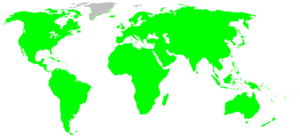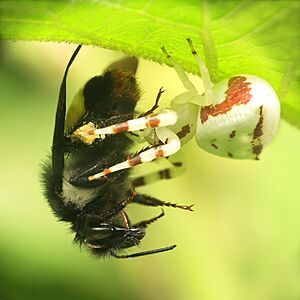Crab spider facts for kids
Quick facts for kids Crab spider |
|
|---|---|
 |
|
| Scientific classification |
|
| Kingdom: | Animalia |
| Phylum: | Arthropoda |
| Subphylum: | Chelicerata |
| Class: | Arachnida |
| Order: | Araneae |
| Infraorder: | Araneomorphae |
| Family: | Thomisidae Sundevall, 1833 |
| Diversity | |
| 171 genera, 2,167 species | |
 |
|
Crab spiders belong to a fascinating family of spiders called Thomisidae. They get their common name because they often hold their front legs out like a crab and can even walk sideways or backward! Many of these spiders are also known as flower spiders because they love to hide on flowers. There are about 170 different groups (called genera) and over 2,100 known types (called species) of crab spiders around the world.
Contents
What Makes Crab Spiders Special?
Crab spiders are unique because they don't spin webs to catch their food. Instead, they are clever ambush predators. This means they wait patiently for an unsuspecting insect to come close, then pounce!
Why are They Called Crab Spiders?
These spiders are called "crab spiders" for a few good reasons. Their bodies are often flat and wide, and they hold their two front pairs of legs spread out. They can also scuttle sideways or backward, just like a real crab. While the Thomisidae family is the main group known as "crab spiders," other spider families sometimes share this name too. For example, some very large spiders are called "giant crab spiders," and others are known as "wall crab spiders."
How to Identify a Crab Spider

Crab spiders have some distinct features. Their two front legs are usually much longer and stronger than their other legs. The back two legs are smaller and often have strong spines. Their colors can be quite varied. Some are dull browns or grays, helping them blend in with bark or soil. Others are bright green, pink, white, or yellow. These vibrant colors help them perfectly match the flowers where they hide. This makes them very hard for prey to spot!
Are Crab Spiders Dangerous?
Most crab spiders are not harmful to people. They are generally small and their venom is meant for insects, not humans. However, it's important to know that some other spiders, which are sometimes also called "crab spiders" (like those in the Sicarius group), are venomous. These are distant relatives of the recluse spiders. Luckily, bites from these more dangerous spiders are very rare.
Amazing Differences Between Males and Females
Male and female crab spiders can look very different from each other. This is called sexual dimorphism. Sometimes, they have different colors. But the biggest difference is often their size. In some species, like the Misumena vatia, the female can be about twice as big as the male. In other species, like Thomisus onustus, the female can be over 60 times heavier than the male!
Scientists have ideas about why these size differences exist. One idea is that larger females can produce more eggs and have healthier babies. Since males don't lay eggs, being bigger doesn't give them the same advantage. Another idea is that smaller males can travel more easily. This helps them find more mates. Larger females, who don't move as much, can catch bigger prey like butterflies and bees. These larger meals give them the extra energy needed to produce eggs.
Clever Hunting Strategies
Crab spiders are masters of disguise and ambush. They don't build webs to catch food. Instead, they use their silk for other things, like safety lines or for reproduction. Many species wait on or near flowers, ready to grab visiting insects. Some, like Misumena vatia, can even change their color over a few days to perfectly match the flower they are sitting on! This amazing camouflage helps them surprise their prey.
Other crab spiders hide among leaves or on tree bark. Some even look like bird droppings, sitting out in the open to fool their prey. Certain species have flat bodies and hunt in tree trunk cracks or under loose bark. They might hide there during the day and come out to hunt at night. Spiders from the Xysticus group hunt in the leaf litter on the ground. In all these cases, crab spiders use their strong front legs to grab their prey and then paralyze it with a venomous bite. Some special crab spiders, like those in the Aphantochilus group, even pretend to be ants to hunt other ants!
Images for kids
-
An ant-mimic Amyciaea spider from India.
See also
- Philodromidae, another family of spiders sometimes called crab spiders
See also
 In Spanish: Arañas cangrejo para niños
In Spanish: Arañas cangrejo para niños









